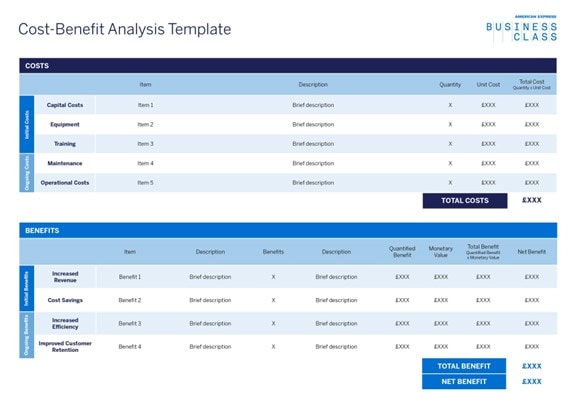Analysing if a new business project will be profitable? A cost-benefit analysis, comparing anticipated costs to potential value, can provide insight into its profitability.
What are the 5 key steps of cost-benefit analysis?
Cost-benefit analysis is a key tool for This Is It Marketing, a digital PR agency based in London, says CEO Elnaz Gerami. “It helps us weigh potential return against investment and means we can use resources more wisely to move the business forward,” she says.
Any cost-benefit analysis needs to be rigorous to be effective; if the analysis doesn’t consider all the costs, for example, the results of the analysis won’t be reliable.
1. Identify project or policy options
The first step in cost-benefit analysis is understanding the context in which a decision will be made. For example, what are the goals of your project? What will ‘success’ look like? This stage of the analysis is critical, says accountant Katya Torres. “The point of the cost-benefit analysis is giving you a map to get where you want to go,” she says. “You might get where you’re going eventually without the map, but it’s going to take a lot longer.”
2. List of benefits and costs
Consider all potential costs and benefits when performing a cost-benefit analysis for a decision, such as launching a new service. This may involve investments in market research, staffing, or marketing. Additionally, consider all expected profits, including the immediate revenue gains and longer-term financial advantages.
Include opportunity costs, which include things like the time invested and alternative use of resources like cash, labour and strategic opportunities that are sacrificed when choosing one option over another.
List the anticipated benefits of your decision, too. These could be higher revenue and sales, improved brand awareness, or establishing your brand as an innovator by being the first to launch an activity or product.
3. Quantify benefits and costs
After compiling your cost-benefit list, assign a comparable value to each item, typically a £ amount, saved time, or employee hours for specific decisions. Ensure value consistency across items for effective comparison.
At This is Marketing, the company uses detailed spreadsheets to track and analyse financial metrics, with specialist software tools and financial modelling for more complex investments. “This process is more detailed the bigger the decision becomes,” says Gerami. “That’s important where we want to understand all potential outcomes.”
The company recently weighed the costs and benefits of investing in a digital marketing platform, including new software purchases and staff training. They evaluated gains like better targeting and attracting high-value clients. “The cost-benefit analysis showed the potential return on investment was substantial, so we decided to go for it, and as a result saw a 20% increase in revenue within the first year,” says Gerami.
To facilitate such investments, the American Express® Business Gold Card can be a valuable tool. It offers longer payment terms of up to 54 days, giving your business the flexibility needed when making financial decisions¹. Moreover, for every full and eligible £1 spent on new business costs, you'll earn 1 Membership Rewards® point which can be redeemed with hundreds of online retailers across travel, retail and dining².
4. Apply discount rates to future benefits and costs
The value of money changes over time because of factors like interest rates and inflation, and this should be reflected in your cost-benefit analysis. "You may need to borrow money to fund an investment, and the interest rates might mean it takes three years rather than two to make a return, which is important to understand," says Torres.
To accurately compute cost-benefit, apply discount rates to gauge how costs and benefits may vary over time due to factors such as inflation. This will aid in determining the present value of future costs and benefits.
5. Compare benefits against costs and make a decision
Once every item on your list of costs and benefits has a value assigned and a timeline, you can easily compare the two lists to see if the benefits of a decision outweigh the costs.
Remember, not only is it about how the costs and benefits compare, but also how this relates to your strategy. Will these benefits help you to achieve your business goals? Are there cost reductions that could be applied, or steps that could be taken to mitigate costs that could reduce benefits?
Strategic reasons to conduct a cost-benefit analysis
Informed decision-making
Conducting a cost-benefit analysis helps your company to make more informed decisions. It encourages you to consider not just the immediate or direct costs of a decision, but also the long-term and indirect costs that might not be so immediately obvious. In this respect, it increases the likelihood that you’ll make the right decision.
Resource allocation
As a business owner, it’s impossible to make every change you’re considering at the same time, and a cost-benefit analysis can help to identify the most cost-effective changes, allowing those to be prioritised.
Risk management
Torres highlights that many projects fail due to unanticipated risks. Cost-benefit analysis, by offering a structured approach, allows businesses to consider factors that may inflate costs or diminish benefits.
Strategic planning
Finally, conducting a cost-benefit analysis allows your business to identify which projects and decisions align best with strategic plans. “As a growing company you only have so many employees, and so much cash in the bank, and you need to prioritise how you use those things to get the best result,” says Torres. “Cost-benefit analysis is about ensuring you can do that.”
Cost-benefit analysis template
This simple cost-benefit template illustrates the key variables that form the analysis. It is divided into two sections covering costs and benefits to help you analyse them systematically.
Firstly, the costs section should detail all expenses associated with implementing a project or decision. It can be further segmented into initial costs, ongoing costs, and, optionally, indirect costs.
Secondly, the benefits section should detail all the positive outcomes associated with implementing the project or decision. Again, this can also be segmented into things like initial benefits, ongoing benefits, and, optionally, intangible benefits.
 |
Once you've added your costs and benefits as comprehensively as possible, your attention should then turn to calculating the net benefit. This is done by subtracting total benefits from total costs, as follows:
Net Benefit = Total Benefit - Total Costs
Cost-benefit analysis vs. cost-effectiveness analysis
Torres explains that cost-benefit and cost-effectiveness are sometimes mixed up. Cost-benefit purely focuses on numerical value, like investing £20,000 in stock to yield £50,000 in sales. “Cost-effectiveness might be looking at how to invest £200 to increase employee engagement and deciding whether to pay £200 that the employee has to pay taxes on, or whether to pay £200 into a health benefit,” says Torres. “What is most cost-effective might not always be the same as what wins out in a cost-benefit analysis.”
1. The maximum payment period on purchases is 54 calendar days and is obtained only if you spend on the first day of the new statement period and repay the balance in full on the due date. If you'd prefer a Card with no annual fee, rewards or other features, an alternative option is available – the Business Basic Card.
2. Membership Rewards® points are earned on every eligible full £1 spent and charged, per transaction. Terms and conditions apply.



